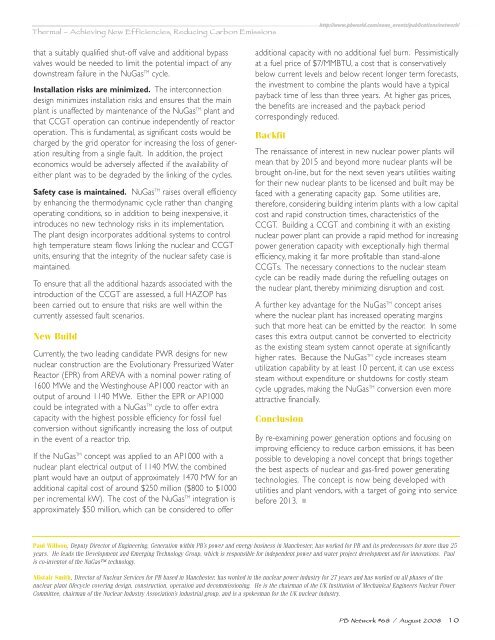Innovation in Global Power - Parsons Brinckerhoff
Innovation in Global Power - Parsons Brinckerhoff
Innovation in Global Power - Parsons Brinckerhoff
Create successful ePaper yourself
Turn your PDF publications into a flip-book with our unique Google optimized e-Paper software.
Thermal – Achiev<strong>in</strong>g New Efficiencies, Reduc<strong>in</strong>g Carbon Emissions<br />
http://www.pbworld.com/news_events/publications/network/<br />
that a suitably qualified shut-off valve and additional bypass<br />
valves would be needed to limit the potential impact of any<br />
downstream failure <strong>in</strong> the NuGas TM cycle.<br />
Installation risks are m<strong>in</strong>imized. The <strong>in</strong>terconnection<br />
design m<strong>in</strong>imizes <strong>in</strong>stallation risks and ensures that the ma<strong>in</strong><br />
plant is unaffected by ma<strong>in</strong>tenance of the NuGas TM plant and<br />
that CCGT operation can cont<strong>in</strong>ue <strong>in</strong>dependently of reactor<br />
operation. This is fundamental, as significant costs would be<br />
charged by the grid operator for <strong>in</strong>creas<strong>in</strong>g the loss of generation<br />
result<strong>in</strong>g from a s<strong>in</strong>gle fault. In addition, the project<br />
economics would be adversely affected if the availability of<br />
either plant was to be degraded by the l<strong>in</strong>k<strong>in</strong>g of the cycles.<br />
Safety case is ma<strong>in</strong>ta<strong>in</strong>ed. NuGas TM raises overall efficiency<br />
by enhanc<strong>in</strong>g the thermodynamic cycle rather than chang<strong>in</strong>g<br />
operat<strong>in</strong>g conditions, so <strong>in</strong> addition to be<strong>in</strong>g <strong>in</strong>expensive, it<br />
<strong>in</strong>troduces no new technology risks <strong>in</strong> its implementation.<br />
The plant design <strong>in</strong>corporates additional systems to control<br />
high temperature steam flows l<strong>in</strong>k<strong>in</strong>g the nuclear and CCGT<br />
units, ensur<strong>in</strong>g that the <strong>in</strong>tegrity of the nuclear safety case is<br />
ma<strong>in</strong>ta<strong>in</strong>ed.<br />
To ensure that all the additional hazards associated with the<br />
<strong>in</strong>troduction of the CCGT are assessed, a full HAZOP has<br />
been carried out to ensure that risks are well with<strong>in</strong> the<br />
currently assessed fault scenarios.<br />
New Build<br />
Currently, the two lead<strong>in</strong>g candidate PWR designs for new<br />
nuclear construction are the Evolutionary Pressurized Water<br />
Reactor (EPR) from AREVA with a nom<strong>in</strong>al power rat<strong>in</strong>g of<br />
1600 MWe and the West<strong>in</strong>ghouse AP1000 reactor with an<br />
output of around 1140 MWe. Either the EPR or AP1000<br />
could be <strong>in</strong>tegrated with a NuGas TM cycle to offer extra<br />
capacity with the highest possible efficiency for fossil fuel<br />
conversion without significantly <strong>in</strong>creas<strong>in</strong>g the loss of output<br />
<strong>in</strong> the event of a reactor trip.<br />
If the NuGas TM concept was applied to an AP1000 with a<br />
nuclear plant electrical output of 1140 MW, the comb<strong>in</strong>ed<br />
plant would have an output of approximately 1470 MW for an<br />
additional capital cost of around $250 million ($800 to $1000<br />
per <strong>in</strong>cremental kW). The cost of the NuGas TM <strong>in</strong>tegration is<br />
approximately $50 million, which can be considered to offer<br />
additional capacity with no additional fuel burn. Pessimistically<br />
at a fuel price of $7/MMBTU, a cost that is conservatively<br />
below current levels and below recent longer term forecasts,<br />
the <strong>in</strong>vestment to comb<strong>in</strong>e the plants would have a typical<br />
payback time of less than three years. At higher gas prices,<br />
the benefits are <strong>in</strong>creased and the payback period<br />
correspond<strong>in</strong>gly reduced.<br />
Backfit<br />
The renaissance of <strong>in</strong>terest <strong>in</strong> new nuclear power plants will<br />
mean that by 2015 and beyond more nuclear plants will be<br />
brought on-l<strong>in</strong>e, but for the next seven years utilities wait<strong>in</strong>g<br />
for their new nuclear plants to be licensed and built may be<br />
faced with a generat<strong>in</strong>g capacity gap. Some utilities are,<br />
therefore, consider<strong>in</strong>g build<strong>in</strong>g <strong>in</strong>terim plants with a low capital<br />
cost and rapid construction times, characteristics of the<br />
CCGT. Build<strong>in</strong>g a CCGT and comb<strong>in</strong><strong>in</strong>g it with an exist<strong>in</strong>g<br />
nuclear power plant can provide a rapid method for <strong>in</strong>creas<strong>in</strong>g<br />
power generation capacity with exceptionally high thermal<br />
efficiency, mak<strong>in</strong>g it far more profitable than stand-alone<br />
CCGTs. The necessary connections to the nuclear steam<br />
cycle can be readily made dur<strong>in</strong>g the refuell<strong>in</strong>g outages on<br />
the nuclear plant, thereby m<strong>in</strong>imiz<strong>in</strong>g disruption and cost.<br />
A further key advantage for the NuGas TM concept arises<br />
where the nuclear plant has <strong>in</strong>creased operat<strong>in</strong>g marg<strong>in</strong>s<br />
such that more heat can be emitted by the reactor. In some<br />
cases this extra output cannot be converted to electricity<br />
as the exist<strong>in</strong>g steam system cannot operate at significantly<br />
higher rates. Because the NuGas TM cycle <strong>in</strong>creases steam<br />
utilization capability by at least 10 percent, it can use excess<br />
steam without expenditure or shutdowns for costly steam<br />
cycle upgrades, mak<strong>in</strong>g the NuGas TM conversion even more<br />
attractive f<strong>in</strong>ancially.<br />
Conclusion<br />
By re-exam<strong>in</strong><strong>in</strong>g power generation options and focus<strong>in</strong>g on<br />
improv<strong>in</strong>g efficiency to reduce carbon emissions, it has been<br />
possible to develop<strong>in</strong>g a novel concept that br<strong>in</strong>gs together<br />
the best aspects of nuclear and gas-fired power generat<strong>in</strong>g<br />
technologies. The concept is now be<strong>in</strong>g developed with<br />
utilities and plant vendors, with a target of go<strong>in</strong>g <strong>in</strong>to service<br />
before 2013.<br />
<br />
Paul Willson, Deputy Director of Eng<strong>in</strong>eer<strong>in</strong>g, Generation with<strong>in</strong> PB’s power and energy bus<strong>in</strong>ess <strong>in</strong> Manchester, has worked for PB and its predecessors for more than 25<br />
years. He leads the Development and Emerg<strong>in</strong>g Technology Group, which is responsible for <strong>in</strong>dependent power and water project development and for <strong>in</strong>novations. Paul<br />
is co-<strong>in</strong>ventor of the NuGas technology.<br />
Alistair Smith, Director of Nuclear Services for PB based <strong>in</strong> Manchester, has worked <strong>in</strong> the nuclear power <strong>in</strong>dustry for 27 years and has worked on all phases of the<br />
nuclear plant lifecycle cover<strong>in</strong>g design, construction, operation and decommission<strong>in</strong>g. He is the chairman of the UK Institution of Mechanical Eng<strong>in</strong>eers Nuclear <strong>Power</strong><br />
Committee, chairman of the Nuclear Industry Association’s <strong>in</strong>dustrial group, and is a spokesman for the UK nuclear <strong>in</strong>dustry.<br />
PB Network #68 / August 2008 10

















